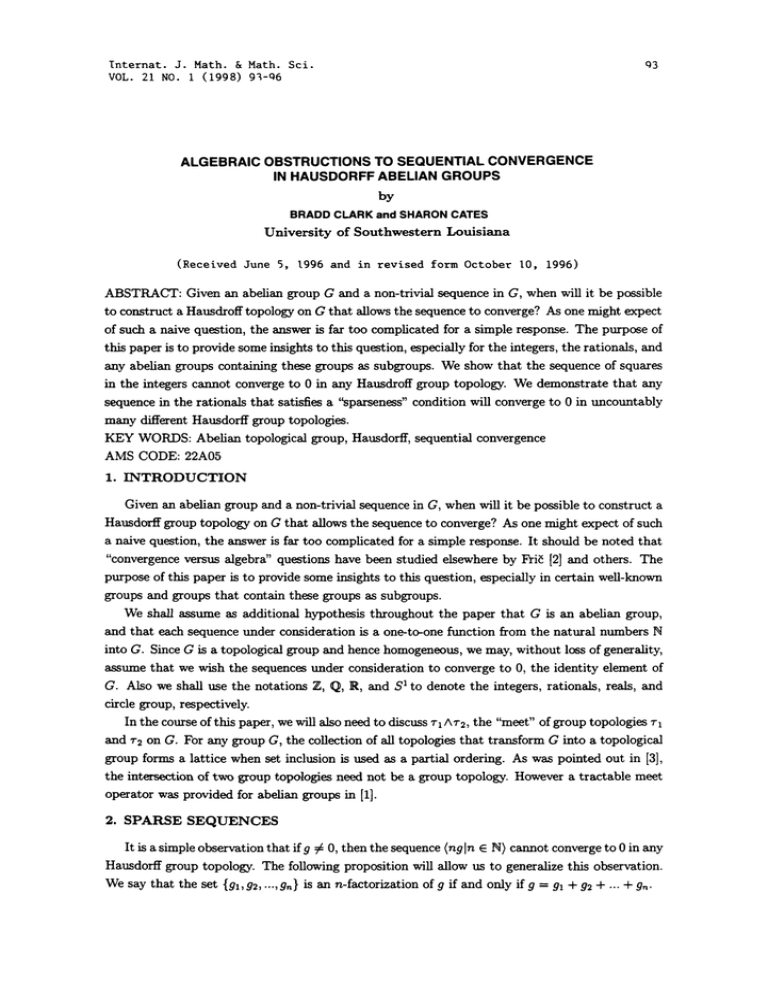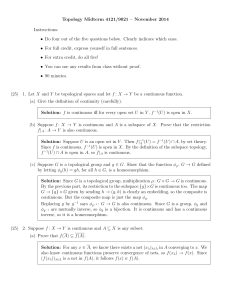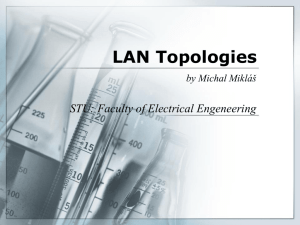CONVERGENCE OBSTRUCTIONS HAUSDORFF ABELIAN GROUPS TO
advertisement

Internat. J. Math. & Math. Sci.
VOL. 21 NO.
(1998) 9-q6
q3
ALGEBRAIC OBSTRUCTIONS TO SEQUENTIAL CONVERGENCE
IN HAUSDORFF ABELIAN GROUPS
BRADD CLARK and SHARON CATES
University of Southwestern Louisiana
(Received June 5, 1996 and in revised form October I0, 1996)
ABSTRACT: Given an abelian group G and a non-trivial sequence in G, when will it be possible
to construct a Hausdroff topology on G that allows the sequence to converge? As one might expect
of such a naive question, the answer is far too complicated for a simple response. The purpose of
this paper is to provide some insights to this question, especially for the integers, the rationals, and
any abelian groups containing these groups as subgroups. We show that the sequence of squares
in the integers cannot converge to 0 in any Hausdroff group topology. We demonstrate that any
sequence in the rationals that satisfies a "sparseness" condition will converge to 0 in uncountably
many different Hausdorff group topologies.
KEY WORDS: Abelian topological group, Hausdorff, sequential convergence
AMS CODE: 22A05
1. INTRODUCTION
Given an abelian group and a non-trivial sequence in G, when will it be possible to construct a
Hausdorff group topology on G that allows the sequence to converge? As one might expect of such
a naive question, the answer is far too complicated for a simple response. It should be noted that
"convergence versus algebra" questions have been studied elsewhere by Fri [2] and others. The
purpose of this paper is to provide some insights to this question, especially in certain well-known
groups and groups that contain these groups as subgroups.
We shall assume as additional hypothesis throughout the paper that G is an abelian group,
and that each sequence under consideration is a one-to-one function from the natural numbers
into G. Since G is a topological group and hence homogeneous, we may, without loss of generality,
assume that we wish the sequences under consideration to converge to 0, the identity element of
G. Also we shall use the notations 7z, Q, R, and S to denote the integers, rationals, reals, and
circle group, respectively.
In the course of this paper, we will also need to discuss 1 At2, the "meet" of group topologies
and r2 on G. For any group G, the collection of all topologies that transform G into a topological
group forms a lattice when set inclusion is used as a partial ordering. As was pointed out in [3],
the intersection of two group topologies need not be a group topology. However a tractable meet
operator was provided for abelian groups in [1].
2.
SPARSE SEQUENCES
.
It is a simple observation that if g 0, then the sequence (ngln l) cannot converge to 0 in any
Hausdorff group topology. The following proposition will allow us to generalize this observation.
We say that the set {gl, g2, g,} is an n-factorization of g if and only if g
B. CLARK AND S. CATES
q4
PROPOSITION 2.1. If {xn},eN is the image set of a sequence that converges to 0 in G
and {xn}nN contains infinitely many pairwise disjoint n0-factorizations of x for some fixed natural
number no, then x E {0}.
PROOF. Let 0 E U an open subset of G. We can find a neighborhood V of 0 such that
noV C_ U. Since the sequence converges to 0, we can find a tail of the sequence in V and hence
find an n0-factorization of x contained in V. Therefore x noV C_ U, and since U was arbitrary,
.
= e (0}.
The referee has pointed out that in a Hausdorit topological group proposition 2.1 can be derived
by considering sequential convergence as a special case of FLUSH-convergence.
This proposition demonstrates an interesting relationship between topological groups and number theory. If the sequence (1, 4,9, ...,n 2, ...) were to converge to 0 in Z, then the sequence
(1, -1, -1, 4, -4, -4, 9, -9, -9, n2, -n2,
...) must also converge to 0. However in [4], it
was demonstrated that there are infinitely many pairs of natural numbers n and m satisfying the
relationship n 2m2 1. Hence by the proposition only the indiscrete topology on 7/. allows the
sequence of squares to converge to 0.
Now consider the sequence (2, 3, 5, ...,p,, ...) where p, denotes the n* prime number. If this
sequence converges to 0, then the sequence (2,-2, 3,-3, 5,-5, ...,p,,-p,,.. must also converge
to 0. Thus by the proposition, if a Hausdorff group topology on Z allows the sequence to converge
to 0, then the twin prime conjecture is false.
-n,
Let {g-},e be the image set of a sequence in G. Then the subgroup H generated by
must be a countable subgroup. Since it is trivial in abelian groups to extend topological group
structures from a subgroup to all of G, it makes sense to study the question of convergence in
specific countable subgroups suc.h as Q. As a special case, suppose that (xk)ke is a sequence of
positive elements of Q. Without loss of generality, we may assume that the sequence is a strictly
in(ireasing sequence. We call such a sequence a sparse sequence if and only if:
k + 3k
for every k lI and
(1.) xk+---! >
2(k + 1)
x
(2.)
x+----A > k + 2k for infinitely many k
x
1.
k+l
PROPOSITION 2.2. If (x)N is a sparse sequence in Q, then there exist uncountably
many Hausdorff group topologies on Q that have (xk)eN converge to 0.
rx.
S by fr(x)
PROOF. For any real number r, we can define a function f, R
If we place the Euclidean topology on S 1, we can use fr to place a group topology on IR. Let
Then since {U}eN is a flmdamental system for the topology on S 1,
in
U
-,
{f-(Uk)} N is a fundamental system for a group topology on IR.
While none of these topologies
are Hausdorff topologies, we note that whenever r is an irrational number, f,[Q is one-to-one,
hence, in this situation the relative topology on Q generated by f, will be a Hausdorff group
,
topology.
Let U
U it is necessary for rx e U. But this means that either
k-1
<rx_<mforsomemZ. Therefore, we must have that
k
mkm
f-(U). If x
1
m_<rx<m+or(rn-1)+
either--m <r< rnk +
x
kx
or
kx
<r<
x
95
SEQUENTIAL CONVERGENCE IN HAUSDORFF ABELIAN GROUPS
Hence forxk
6
Uk, it is necessary that
r 6
U,,ez
ink-1
kxk
( ink+l)
+
)+ 1) (ink-1mo(k +kxk+ +).
t shw that given an interval frm
mk
V’ say
mk+l
kxk
Vk
C
R. We wish
/
there exists an integer
m
mk
mo(k + l)
For this to happen, it is necessary
(k+ 1)z+,
rnk- 1
rnk +
mo(k
1)
and sufficient for
and
<
<
(k+ 1)x+,
(k+ 1)x+l
kx
kx----’ or equivalently that
that
+ l)
(mo(k
(k+ 1)x+,
"
(ink- 1)z+l
+
kx
Since
< mo<
(ink + 1)Zk+l
kz
k+
<x>eN is sparse, we have that:
(ink + 1)x+,
(ink- 1)xk+,
kx
kx
2
k+
>
(ink + 1)(k + 3k)
2k(k + 1)
(ink- 1)(k + 3k)
2k(k + 1)
2
k+
Thus each interval used in forming V contains at least one full interval from the construction of
Vk+l"
k2 / 2k
Now infinitely often we have that x----! >
Using a similar argument to the above, we
k+
x
can show that for infinitely many k, every interval in V contains two intervals from V +1. But
this means that C=, V contains a Cantor set and hence is uncountable. Therefore, there exist
uncountably many irrational numbers r that generate Hausdorff group topologies on Q that have
the sequence
If
(xk>keN converging to 0.
{x,},eN is the image set of a sequence in Q,
we can decompose {x,},eN into two subsets,
where each y, > 0and each zj < 0. Following a rearrangement of terms, we
can assume that y,+, > y, and z3+1 < z3 for all i, j 6 N.
{y,},eN and {zj}3
COROLLARY 2.3. If
<x,,>,s
is a sequence in Q with corresponding sequences (Y,>,N and
and {Y,},es t3 {Iz31}3s is the image of a sparse sequence, then there are uncountably
many Hausdorff group topologies on Q which have <x,>,eN converge to 0.
<lz31)3N
The method that we have used to construct group topologies on Q has its limitations. If we use
it to create group topologies r, and r2 in which the sparse sequences (x,),es and (y,), converge
to 0, then we can be sure that the combined sequence (xl, yl, x2, y2,x3, y, ...) will converge to 0 in
7"
A r2. However by
[1],
we know that
n
rl
+
m
r2
+ (-e, e)ln, m Z and e > 0
is a fundamental
system for r, A r2 where r, and r2 are the irrationals associated with the topologies r, and r
respectively. Now r A r2 will be a Hausdorff topology if and only if rl 6 Q, and will be the
r2
indiscrete topology otherwise.
H Q is an isomorphism into Q. We say that a sequence
Suppose that H < G and that
(x,),s in H is a sparse in H if and only if ((x))e is sparse in Q.
PROPOSITION 2.4. Let H < G be a direct sum of cyclic groups and groups isomorphic
(x,),s is a sequence in H whose associated coordinate sequences are either sparse or
eventually 0, then there is a Hausdorff group topology on G that has <x,>,es converging to 0.
to Q. If
ACKNOWLEDGEMENT. The authors
preparation of this paper.
are grateful to the referee for his suggestions in the
96
B. CLARK AND S. CATES
[1] B. Clark
.
and
Math. Bull. 29
IFEKENCES
Schneider, "The meet operator in the lattice of group topologies," Canad.
(1986), 478-481.
[2] R. Fri., "Convergence and numbers," Topology Appl. 70 (1996), 139-146.
[3] P. Samuel, "Ultrafilters and compactifications of uniform spaces," Trans. Amer. Math. Soc. 64
(1948), 100-1.
[4] D. Shanks, "Solved and Unsolved Problems in Number Theory," Second Edition, Chelsea
Publishing Company, New York, 1978.


![MA342A (Harmonic Analysis 1) Tutorial sheet 2 [October 22, 2015] Name: Solutions](http://s2.studylib.net/store/data/010415895_1-3c73ea7fb0d03577c3fa0d7592390be4-300x300.png)

